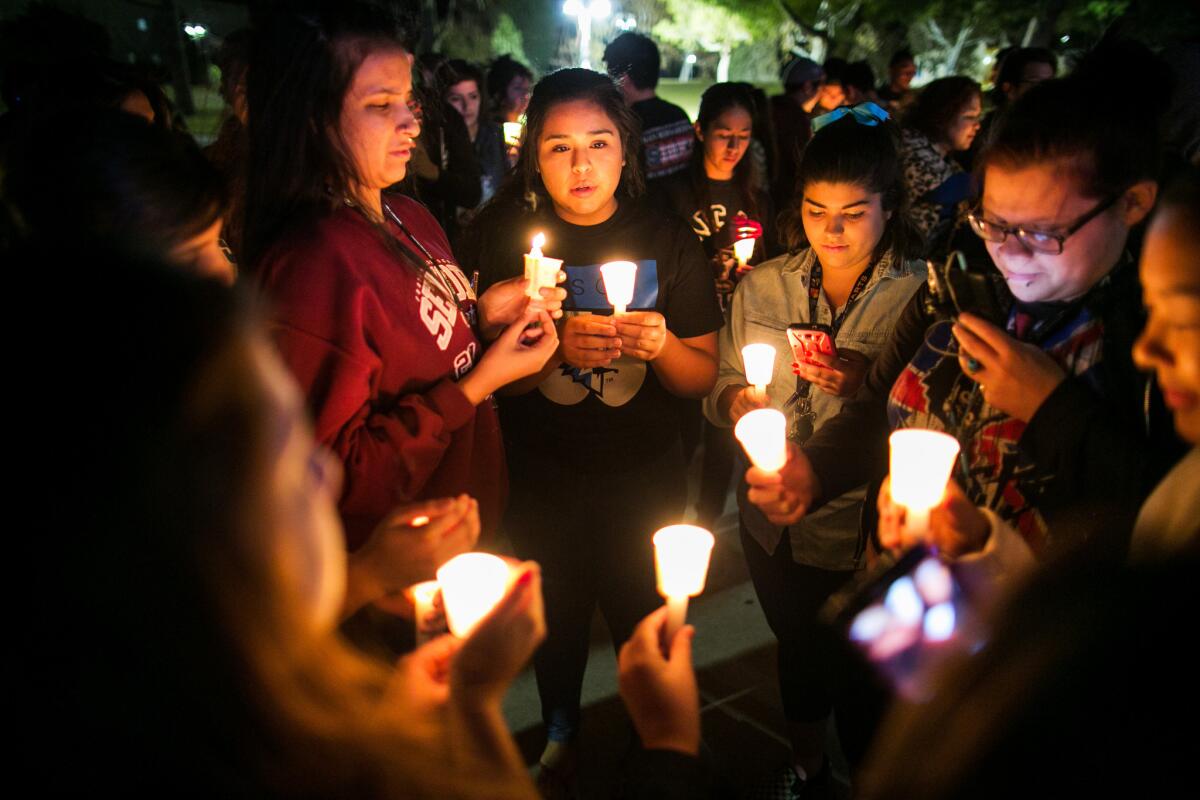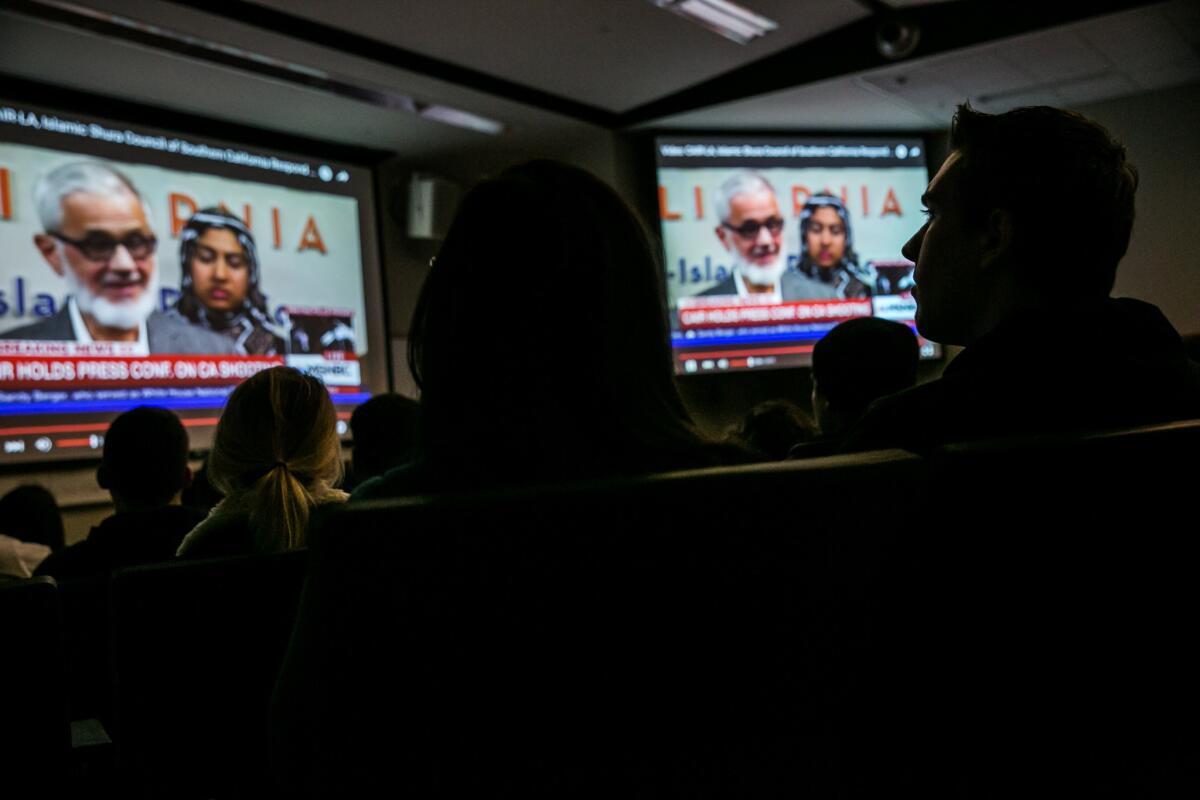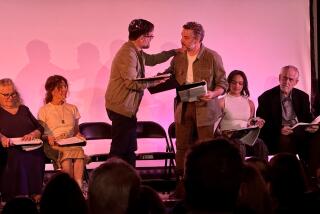Cal State San Bernardino class on Islamic world grapples with students’ questions about shooting
- Share via
Professor Dany Doueiri stood at the front of a lecture hall dressed in jeans, with a red polo shirt peaking out of a dark sweater.
“You’re living a historic moment,” Doueiri told his students in the World of Islam class. “Tonight is your night. You’re going to speak up.”
About 200 Cal State San Bernardino students looked back at him, some sipping from Red Bull cans or red Starbucks cups to fuel the last lecture of the quarter.
Monday night’s lecture was a deviation from the plan -- not in itself unusual. Doueiri changes the class’ syllabus almost every week, often for world events such as the recent attacks in Paris or Lebanon.
Then last Wednesday, the mass killing of 14 people closer to home at the Inland Regional Center in San Bernardino brought an even more dramatic shift in Doueiri’s lecture.
At least four students or their parents called Doueiri before Monday evening’s class, saying that they would not attend because they were afraid of retaliation against the school.
Eight years before, a Cal State San Bernardino student named Syed Rizwan Farook was enrolled in the World of Islam course. Doueiri had to dig to discover this fact: He’s not sure he taught Farook, and if he did, he has no memory of him.
Now Farook’s identity was, with that of his wife, Tashfeen Malik, seared into recent history as the architect of the worst mass shooting in the U.S. since the massacre at Sandy Hook Elementary School in Newtown, Conn. Federal officials have said they are investigating the attack as an act of terror.
And so Doueiri was in class late on a Monday to deliver something more than the typical class lecture.
“At this point in time, some of you may be so traumatized,” Doueiri told the class. “We’ve just got to be careful how...we express our sorrow.”
FULL COVERAGE: San Bernardino terror attack | Live updates
Doueiri generally focuses on teaching a historical understanding of Islam and Islamic culture, including misconceptions about Muslims that spread after such attacks.
But he didn’t expect that he would have to teach students about a massacre that occurred a few miles from his campus -- perpetrated by a man who had taken the class in 2007.
Because the World of Islam class fulfills a general education requirement, roughly one sixth of students take it, Doueiri said. He teaches most of the classes.
Cal State San Bernardino is about 9 miles from the site of the massacre. No one on campus was harmed Wednesday, but the university is inextricably tied to the shooting.

Community members and students hold candles at a vigil for shooting victims.
Thousands of students commute from around the county, and many alumni go on to work in the area. Farook graduated from the school with an environmental health science degree in 2010. Five of the people he and his wife killed were alumni.
Yvette Velasco and Shannon Johnson -- two of the people killed last week during a holiday party -- walked the same halls as Farook.
“There are so many intersections,” Cal State San Bernardino President Tomás Morales said. “We are San Bernardino.”
Doueiri, director of the university’s Arabic-language program, developed the class in 2003 in response to calls from campus and community members who wanted to understand Islam after the 9/11 attacks.
Many call him “professor Dany.” He is close to students, he jokes with them, reminding them that Muslims as a group are not violent or hateful. On Monday night, he opened the floor to their questions.
In the second row a student raised his hand and asked why Doueiri canceled a field trip to a local Islamic center.
“For security purposes,” Doueiri responded. He didn’t want to put his students in danger.
He showed the class a clip of Muslim leaders decrying the attacks on the day they occurred -- a sign that the Muslim community spoke out early and quickly against the killers. It was also a reminder that the attackers do not represent most Muslims.

Students watch a news program in Dany Doueiri’s World of Islam class.
One student in the back of the room raised her hand, and asked for a Quran verse she can quote to naysayers to prove that Islam does not condone violence.
Doueiri provided the verse, and repeated it later when he spoke to hundreds more at a campus vigil -- ”Whoever kills a soul kills all humanity,” Doueiri paraphrased.
Some questions were more complicated.
One student asked whether it’s possible that people might see suspicious behavior and not report it because they were afraid of being perceived as prejudiced.
“You know what? Report us,” Doueiri said, to laughs from the room. “You won’t be hurting me, you will be doing me a favor.”
Then he took a serious note as the laughter subsided. Farook “just attacked my religion,” Doueiri said. “These people make our life much harder.”
Another student pushed back: What’s the difference between reporting suspicious behavior and racially profiling Muslims, she asked.
“Look, there is a fine line,” Doueiri said, adding that the perceived risk from Muslim terrorists is much greater than the actual risk of being attacked by one in the U.S.
He didn’t, however, really answer the question.
In an interview after class, Doueiri said that what he should have said is this: “Suspicious behavior is behavior that should alert you regardless of a person’s race or creed.”
A Muslim praying as he or she normally would, Doueiri said, should not constitute suspicious behavior.
The class was supposed to leave the lecture hall at 6:30 p.m. to walk to a campus vigil, but at 6:45 p.m., Doueiri was still talking. He finally got a call about 6:50 p.m., asking him to get to the vigil in time for his speech on behalf of the local Muslim community.
The class still had its preparations for that field trip to the Islamic center — there was Saudi coffee, platters of Middle Eastern bread and desserts, American cream puffs and cookies. Instead of taking everything to the Islamic center, they took it to the vigil.
Reach Sonali Kohli on Twitter @Sonali_Kohli or by email at Sonali.Kohli@latimes.com.
MORE ON SAN BERNARDINO
Where Muslims (mostly) don’t live
Ignoring Donald Trump didn’t work for Republicans. What now?
San Bernardino shooting updates: ‘In 5 seconds,’ medics determined who had survived the attack
More to Read
Sign up for Essential California
The most important California stories and recommendations in your inbox every morning.
You may occasionally receive promotional content from the Los Angeles Times.











